Commander-in-Chief of the Forces
The Commander-in-Chief of the Forces, later Commander-in-Chief, British Army, or just the Commander-in-Chief (C-in-C), was the professional head of the English Army from 1660 to 1707 (the English Army, founded in 1660, was succeeded in 1707 by the new British Army, incorporating existing Scottish regiments) and of the British Army from 1707 until 1904.
In most instances, Commanders-in-Chief of the Forces were not cabinet members. Instead, the British Army was represented variously in government by the Paymaster of the Forces (Paymaster General), the Master-General of the Ordnance, the Secretary at War (who was not usually a member of the Cabinet) and the Secretary of State for War.
The office was replaced in 1904 with the creation of the Army Council and the appointment of Chief of the General Staff.
Origins
On 21st February 1660, the reconstituted Long Parliament resolved "that General George Monck be constituted and appointed Captain-General and Commander in Chief, under Parliament, of all the Land-Forces of England, Scotland and Ireland".[1]
After Moncks's death, the post (which gave the holder significant military power) was abolished, until James Scott, 1st Duke of Monmouth successfully petitioned the King and was granted it in 1674.[2] After Monmouth's execution the post was again not filled until 1690, when it was bestowed upon John Churchill, Earl of Marlborough, during the King's absence in Ireland; (it was likewise conferred on the Duke of Schomberg the following year during the King's absence in Flanders, Marlborough having fallen from favour).
Later history
With the appointment of General Lord Jeffrey Amherst in 1793, the Commander-in-Chief was given authority over matters of discipline, over supplies, training and promotions in the British Army. The establishment of a military staff took place under the oversight of his successor, HRH The Duke of York.[3]
With the demise of the Board of Ordnance in the wake of the Crimean War the Commander-in-Chief assumed command of the Ordnance troops: the Royal Regiment of Artillery and the Corps of Royal Engineers. The momentum of reform at this time, however, was toward increasing the authority of the Secretary of State for War. From the passing of the War Office Act 1870, as part of the Cardwell reforms, the C-in-C was made clearly subordinate to the Secretary of State, to serve as the latter's principal military adviser, and was made to move out of his traditional office above the arch at Horse Guards and into the War Office. Nevertheless, in 1888 he is still described as having responsibility for all personnel and matériel issues for the army and auxiliary forces, and in 1895 he took on the responsibilities of chief of staff.[3]
The post was finally abolished by recommendation of the Esher Report, set up in the wake of the Second Boer War, which established the office of Chief of the General Staff.[3]
Officeholders
General-in-Chief Command (1660–1793)
| Rank | Name | Image | In office | Reference |
|---|---|---|---|---|
| General | George Monck, 1st Duke of Albemarle |  |
3 August 1660 – 3 January 1670 | [4] |
| Vacant | 3 January 1670 – 30 March 1674 | |||
| General | James Scott, 1st Duke of Monmouth | 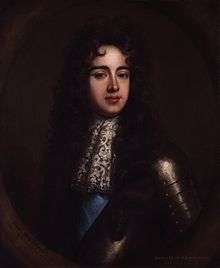 |
30 March 1674 – 1 December 1679 | [5] |
| Vacant | 1 December 1679 – 3 June 1690 | |||
| General | John Churchill, 1st Earl of Marlborough | .jpg) |
3 June 1690 – 30 April 1691 | [6] |
| General | Meinhardt Schomberg, 3rd Duke of Schomberg |
 |
30 April 1691 – 1691 | [7] |
| Vacant | 1691 – 24 April 1702 | |||
| General | John Churchill, 1st Earl of Marlborough | .jpg) |
24 April 1702 – 1708 | [6] |
| Vacant | 1708 – 1 January 1711 | |||
| General | James Butler, 2nd Duke of Ormonde | 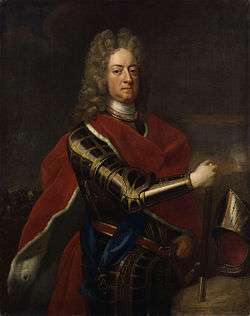 |
1 January 1711 – 1714 | [8] |
| Vacant | 1714 – 1 January 1744 | |||
| Field Marshal | John Dalrymple, 2nd Earl of Stair | _General_and_Diplomat.jpg) |
1 January 1744 – 1744 | [9] |
| Field Marshal | George Wade |  |
1744–1745 | [10] |
| Vacant | 1745–1745 | |||
| General | Prince William, Duke of Cumberland |  |
1745 – 24 October 1757 | [11] |
| Field Marshal | John Ligonier, 1st Earl Ligonier | 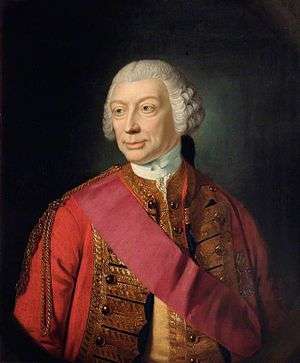 |
24 October 1757 – 1759 | [12] |
| Vacant | 1759 – 13 August 1766 | |||
| General | John Manners, Marquess of Granby | 13 August 1766 – 1769 | [13] | |
| Vacant | 1769 – 19 March 1778 | |||
| Field Marshal | Jeffery Amherst, 1st Baron Amherst |  |
19 March 1778 – 29 March 1782 | [14] |
| Field Marshal | Henry Seymour Conway | 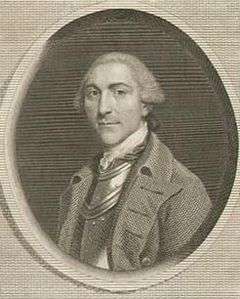 |
29 March 1782 – 21 January 1793 | [15] |
Commander-in-Chief (1793–1904)
| Rank | Name | Image | In office | Reference |
|---|---|---|---|---|
| Field Marshal | Jeffery Amherst, 1st Lord Amherst |  |
1793–1795 | [16] |
| Field Marshal | Prince Frederick, Duke of York | 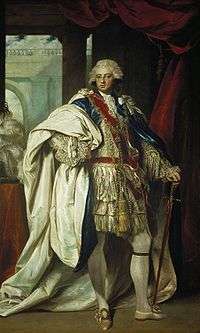 |
1795–1809 | [17] |
| General | Sir David Dundas | 1809–1811 | [18] | |
| Field Marshal | Prince Frederick, Duke of York |  |
29 May 1811 – 22 January 1827 | [19] |
| Field Marshal | Arthur Wellesley, 1st Duke of Wellington |  |
22 January 1827 – 22 January 1828 | [20] |
| General | Rowland Hill, 1st Lord Hill | .jpg) |
22 January 1828 – 15 August 1842 | [21] |
| Field Marshal | Arthur Wellesley, 1st Duke of Wellington |  |
15 August 1842 – 14 September 1852 | [22] |
| Field Marshal | Henry Hardinge, 1st Viscount Hardinge | 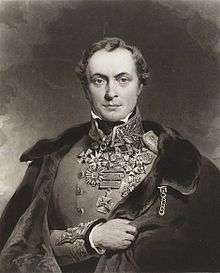 |
28 September 1852 – 5 July 1856 | [23] |
| Field Marshal | Prince George, Duke of Cambridge |  |
5 July 1856 – 1 November 1895 | [24] |
| Field Marshal | Garnet Wolseley, 1st Viscount Wolseley | 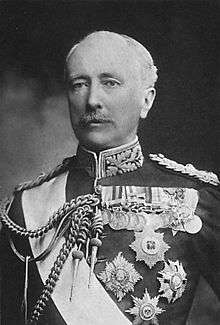 |
1 November 1895 – 3 January 1901 | [25] |
| Field Marshal | Frederick Roberts, 1st Earl Roberts |  |
3 January 1901 – 12 February 1904 | [26] |
References
- ↑ Journals of the House of Commons, volume eight. London: HM Stationery Office. 1813. p. 847.
- ↑ Roberts, George (1844). The Life, Progresses and Rebellion of James, Duke of Monmoutj. London: Longman, Brown, Green and Longmans. p. 36.
- 1 2 3 Raugh, Harold E. (2004). The Victorians at War, 1815-1914: an Encyclopaedia of British Military History. Santa Barbara, California: ABC-CLIO Inc.
- ↑ "George Monk". Oxford Dictionary of National Biography. Retrieved 21 January 2014.
- ↑ "James Scott, 1st Duke of Monmouth". Oxford Dictionary of National Biography. Retrieved 21 January 2014.
- 1 2 "John Churchill, 1st Duke of Marlborough". Oxford Dictionary of National Biography. Retrieved 21 January 2014.
- ↑ "Meinhardt Schomberg, 3rd Duke of Schomberg". Oxford Dictionary of National Biography. Retrieved 21 January 2014.
- ↑ The London Gazette: no. 4948. p. 1. 3 January 1711. Retrieved 21 January 2014.
- ↑ "John Dalrymple, 2nd Earl of Stair". Oxford Dictionary of National Biography. Retrieved 21 January 2014.
- ↑ Heathcote, p. 286
- ↑ "Prince William, Duke of Cumberland". Oxford Dictionary of National Biography. Retrieved 21 January 2014.
- ↑ Heathcote, p. 203
- ↑ "John Manners, Marquess of Granby". Oxford Dictionary of National Biography. Retrieved 21 January 2014.
- ↑ Heathcote, p.25
- ↑ Heathcote, p.94
- ↑ "Jeffery Amherst, 1st Baron Amherst". Oxford Dictionary of National Biography. Retrieved 21 January 2014.
- ↑ Glover, (1973), p.128
- ↑ "Sir David Dundas". Oxford Dictionary of National Biography. Retrieved 21 January 2014.
- ↑ The London Gazette: no. 16487. p. 940. 21 May 1811. Retrieved 21 January 2014.
- ↑ The London Gazette: no. 18327. p. 153. 23 January 1827. Retrieved 21 January 2014.
- ↑ "Rowland Hill". Oxford Dictionary of National Biography. Retrieved 21 January 2014.
- ↑ The London Gazette: no. 20130. p. 2217. 16 August 1842. Retrieved 21 January 2014.
- ↑ The London Gazette: no. 21362. p. 2573. 28 September 1852. Retrieved 21 January 2014.
- ↑ Heathcote, p. 142
- ↑ The London Gazette: no. 26676. p. 5923. 1 November 1895. Retrieved 21 January 2014.
- ↑ The London Gazette: no. 27263. p. 83. 4 January 1901. Retrieved 21 January 2014.
Sources
- Glover, Richard (1963). Peninsular Preparation: The Reform of the British Army 1795–1809. Cambridge University Press.
- Heathcote, Tony (1999). The British Field Marshals 1736–1997. Pen & Sword Books Ltd. ISBN 0-85052-696-5.